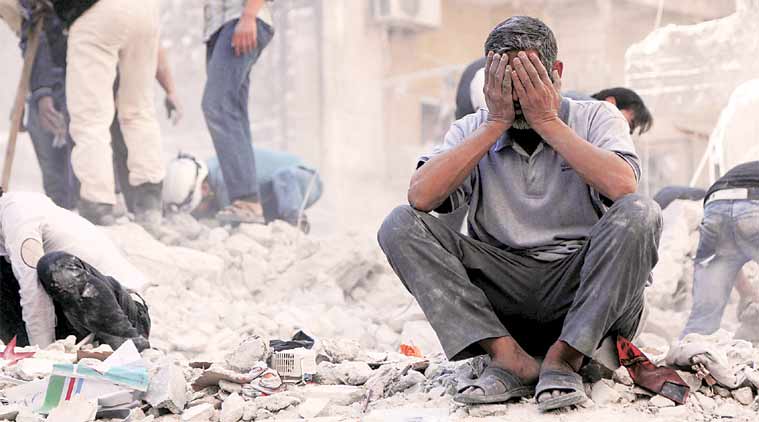Opinion The Syrian question
Fate of millions of refugees depends on whether the ceasefire can lead to a peace process

 A man breaks down after Syrian army’s barrel bombs hit his house in Aleppo. (File/Reuters)
A man breaks down after Syrian army’s barrel bombs hit his house in Aleppo. (File/Reuters)
The conflict in Syria is one of the greatest humanitarian tragedies of recent times. According to a recent report by the Syrian Centre for Policy Research, an independent think tank, about 4,70,000 Syrians have lost their lives due to the war, directly and indirectly, so far. Around 45 per cent of the country’s population of 23 million has been displaced, 6.4 million internally and more than 5 million abroad. In all, 11.5 per cent of Syria’s population has been killed or injured since the crisis erupted in March 2011, the report estimates.
However, the international community woke up to this tragedy only when tens of thousands of Syrian refugees started landing on European shores, mainly in Greece, in 2015 from various points on the Turkish coastline. Many of them drowned while crossing the Aegean Sea in rickety boats provided by human traffickers.
The Syrian conflict has now entered its sixth year. No one expected it to last this long. And neither did anyone expect it to produce consequences far beyond its borders, or draw in nuclear-armed states. It had taken NATO about seven months to get rid of Muammar Gaddafi. Many of the powers involved in the Libyan operation are also involved in Syria. Their expectation was that it might take them a little longer to get rid of the Bashar al-Assad regime. But that didn’t happen. So what went wrong? It is important to understand the true nature of the Syrian crisis to find answers to the issues raised above.
It began rather innocuously after the Arab Spring broke out in Tunis in January 2011. Around the same time, small, peaceful demonstrations took place in Syria, demanding political reforms. They were crushed brutally by Assad’s security forces, resulting in deaths of many civilians. However, the size of the demonstrations continued to increase, as also the incidence of violence. Several incidents also involved foreign nationals, pointing to external involvement in the Syrian imbroglio at a relatively early stage.
Several observers have noted that trained Islamist foreign fighters and weapons had started entering Syria covertly from areas along the Syrian border as early as March 2011. Their entry was organised by the intelligence agencies of some Western, Gulf, and regional states. President Assad soon changed his approach, offering to discuss wide-ranging political reforms with the demonstrators. On April 21, he repealed the emergency laws in place since 1963, under which the government had sweeping authority to suspend constitutional rights.
By that time the die had been cast. The foreign powers had seen in the Arab Spring an opportunity to effect regime change in Syria, as they had done in Libya. The Assad regime was inconvenient to them because Assad was an ally of Russia and Iran, and permitted transit of Iranian weapons through Syrian territory to Hezbollah in Lebanon, which Israel saw as a threat. If he were dislodged, both Iran and Hezbollah would be weakened. This was the main strategic rationale behind the regime change plan of the external powers though there were other reasons also.
In the initial stages of the conflict, the West, the Gulf and Turkey openly provided weapons, training and funding to an outfit called the “Free Syrian Army” (FSA), which consisted mainly of defectors from the Syrian army. Its high command was based in Turkey. However, the FSA was increasingly wracked by infighting and defections to jihadi groups such as the Al Qaida-linked Nusra Front, which were also operating in Syria. Then, in March 2013, IS took control of the Syrian town of Raqqa and quickly expanded its presence in the country.
An important turning point came in September 2015, when, in response to a request from President Assad, Russia intervened militarily in the Syrian conflict. Within a period of a few months, the Russian air force crippled the supply lines of weapons and foreign fighters
from Turkey to Syria. It also destroyed almost 2000 oil tanker trucks, which were being used by IS to smuggle Syrian oil to Turkey. It was an important source of funds for IS.
Under Russian air cover, the beleaguered Syrian military, aided by Hezbollah fighters, the Syrian Kurds, and Iranian advisors, gradually retook many critical areas controlled by IS and Nusra Front, changing the ground situation in Assad’s favour.
On February 12, the US and Russia announced a partial ceasefire, which came into effect on February 27, and is still mostly holding. The atmosphere appears conducive to a peace process. But there are dangerous pitfalls along the way.
First, have the West, the Gulf, and Turkey given up their objective of regime change in Syria? Second, what will happen to IS, Nusra Front, Ahrar al-Sham, and other jihadi and Islamist groups? Will their external backers agree to withdraw their support to them? Third, what will the EU do about the tens of thousands of Syrian refugees stranded in Greece? Will the EU-Turkey agreement of March 18 work? Finally, what will happen to the almost five million Syrian refugees in camps in Turkey, Lebanon, Jordan, and Iraq? Will they be able to return to Syria?
Developments in the coming days will hopefully provide answers to the above questions. The acute misery that the Syrian people have faced over the last five years — most of it not of their making — must come to an end. They deserve better than what they have suffered so far.




